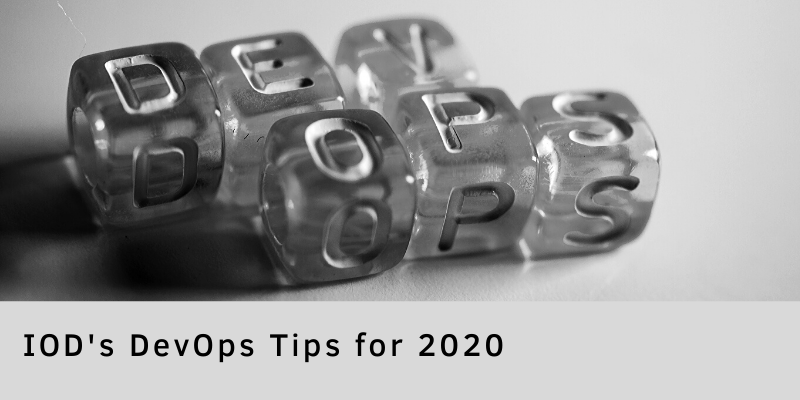DevOps is a young mindset, and, year after year, it continues to evolve into something that’s bigger in scope, better in implementation, and greater in its expectations. Up until now, the industry’s focus has been on establishing DevOps as a practice. Now, we’re moving on to bigger and better things.
Growth like this is essential, since, without it, innovation in software design and delivery would stagnate. Companies embracing DevOps report a 43% increase in development productivity. As DevOps evolves, you will need to change your development practices to match it. This will help add value to your business as well as to your career.
In this article, you’ll learn about three trending changes that industry leaders are making to their DevOps pipelines in 2020. We’ll talk about why these strategies are game changers and how they can help your organization.
DevOps expert? We’re hiring.
1. DevSecOps: Further Left in the Pipeline
Bringing security into the CI/CD pipeline is one of the biggest DevOps developments in 2020. When you think about it, pipelines are the natural place to integrate security. If something bad is discovered in the CI/CD pipeline, you can still put a pause on a release relatively easily. The stages in your pipeline can produce all the reports and documentation necessary to breeze past an audit.
When security comes in after deployment, it can be too late in the process for any needed changes to be implemented. Having security look at your code before deployment can be just as bad, since any last minute or emergency changes you make during the deployment won’t be incorporated in their analysis. In either situation, security seems like a burden to developers. Developers get frustrated, and delays are introduced into your system. The ideal time to focus on security is during the development process. By finding vulnerabilities and audit deficiencies early on, you can implement needed changes before you progress to higher environments like quality assurance or production.
By using a product like Octopus Deploy or Azure Pipelines, you can add in steps for security teams that will enable them to perform their work seamlessly. These steps can include calling the API of a security product or using an event broker to handle requests—tasks that should be simple enough for your DevOps teams to do. Plus, having an embedded security expert on the DevOps team will help with the analysis of what should happen once the security step is complete.
Doing DevSecOps earlier is a powerful change because it incorporates security as a business deliverable. For too long, security has been seen as an inhibitor to getting things done. When you implement a DevSecOps mindset, you see an improvement in your security posture while maintaining your release cadence. This helps the business. Security moves their implementation “further left” in the pipeline, catching and remediating issues before they become critical vulnerabilities. Developers get to see improvement in their security posture and are less likely to see security implementation as a waste of time. Finally, the business gets to release fixes and features faster with fewer delays. It’s a win/win/win for the whole company; and, most importantly, it’s a win for your customers.
Are you interested in joining IOD’s growing global network of freelance tech experts and writers? Contact us and start to see for yourself how freelancing may be the preferred lifestyle choice for you this year.
2. Automation: Zero Touch Deployment
You can’t talk about DevOps without talking about automation. Today, many companies have pipelines comprised mostly of automatic processes. These are considered to be “low touch”— meaning someone needs to press a button or approve a release before it can be deployed. From here on out, however, “zero-touch” deployments will be the goal.
A zero-touch deployment could be triggered by a merge of code into the master branch of a repository, or it could be launched when a sprint is closed in your favorite Kanban board. Either way, you can expect fewer human interactions when it comes to deploying code. Any passwords, encryption keys, user accounts, or even entire cloud environments will be stood up and torn down without anyone getting involved.
Once your deployments are truly zero-touch, you’ll notice something interesting. They’ll be able to happen at any time of day—including peak times. This has the potential to introduce chaos into your environment. When chaos gets introduced, DevOps engineers like to bring back order. Therefore, the natural evolution of a zero-touch deployment is the zero-downtime deployment.
Think about your technology stack for a moment. You’ll have a web layer, an application layer, a database layer, and maybe more. Each one of these layers of your environment will need a unique approach if you’re going to seamlessly deploy your technology behind the scenes.
When implementing a zero-downtime deployment, it is essential to take the customer’s perspective. If they’re interacting with your tech stack mid-deployment, what happens to their web session when the code gets upgraded? When a server gets deployed? When a load balancer sends them to a different server?
Implementing automation at this scale will take a huge amount of teamwork and cooperation, but you’ll see a massive return if you’re able to pull it off. Using immutable servers and containers in conjunction with load balancers may be the answer, or we may see some new technology rise up to address these zero-downtime conundrums.
3. DevOps with AI and ML
DevOps professionals are all too familiar with implementations gone wrong. Hopefully, you’ve only experienced this in development and staging environments, and not in production!
While DevOps engineers are great at identifying what went wrong and how to fix it, they can only burn so many cycles and fight fires for so long. The next step in DevOps’ evolution is to incorporate artificial intelligence (AI) and machine learning (ML) into the process to assist engineers with routine but unexpected tasks like fixing problems and fighting bugs.
Many industries are now using data-driven approaches to handle their decision making, and the technology industry is heading in the same direction. AI and ML can help you learn when and how to deploy new environments and even make these changes for you on the fly.
Monitoring your systems in the cloud is quite easy, and most companies include monitoring in their DevOps pipelines. If you tie AI and ML into the monitoring systems, you can find out a lot of information about your deployments. For instance, you could pull your monitoring data from AWS CloudWatch into AWS SageMaker. In SageMaker, you could train a data set to recognize when one region or availability zone is becoming overloaded. From there, you could create triggers using AWS SQS to scale your deployment. Or, if a different region is being underutilized, you could have a load balancer send more traffic that direction. The possibilities are endless when you start incorporating automated, data-driven decisions into your stack.
The most exciting implication of AI and ML in DevOps is the possibility of programming self-healing and self-repairing systems. Automation and early detection could enable your algorithms to keep your systems up and running when you’d normally be grabbing a coffee and gearing up for a late night of on-call duties.
Are you a tech marketing professional? Check us out.
Conclusion
DevOps doesn’t stay the same for long, and each of the many changes that occur to this relatively new approach propel the industry towards an exciting future. That said, you shouldn’t come away from this article thinking that each of these up-and-coming practices needs to be implemented in your organization right now. DevOps is a journey, and each organization is at a different point along the path.
If you’re just now implementing DevOps, the best thing you can do is integrate security into your pipelines. By starting out with this best practice established, you’ll set yourself up for success as you continue further along. If you already have some DevOps practices established, go one step further and automate your deployments to the point they could be considered zero touch. The most stable production environment is one that doesn’t have human hands all over it.
If zero touch deployments are old news, then it’s time to get serious with AI and ML. By reducing the need for a human being to monitor, troubleshoot, and scale your deployments, you can truly reap the benefits of DevOps. You’ll be able to reduce overhead while increasing performance and ultimately creating a better customer experience.
Once you’ve implemented the steps mentioned in this article, it’s worth checking back in with the evolution of DevOps. By that point, there are bound to be more trends worth investigating.






